September 10, 2021
Air Date: September 10, 2021
FULL SHOW
SEGMENTS
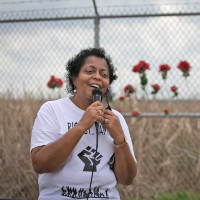
Hurricane Ida Adds Misery To Cancer Alley,’ Part 1
View the page for this story
In the aftermath of Hurricane Ida, the communities of the Louisiana region known as ‘Cancer Alley’ were left to deal with destroyed homes, no electricity, and polluted water. That’s on top of the toxic air they breathe every day because of industrial pollution, and Black residents have been fighting for environmental justice there for decades. Sharon Lavigne is the founder of RISE St. James and a 2021 Goldman Prize recipient for her work in organizing against a massive Formosa plastics plant, and she joins Host Steve Curwood to discuss the hurricane’s impacts and the health effects of industrial pollution in her community. (13:28)
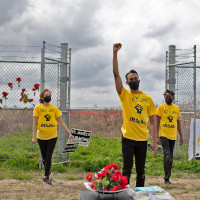
Hurricane Ida Adds Misery To ‘Cancer Alley,’ Part 2
View the page for this story
Hurricane Ida left Louisiana's ‘Cancer Alley’ with crumbling homes and infrastructure, in a region that already suffers from toxic pollution as well as some of the highest cancer and Covid-19 death rates in the United States. Sharon Lavigne, founder of the environmental justice nonprofit RISE St. James, continues her conversation with Host Steve Curwood about the efforts to stop a multi-billion-dollar plastics facility and how Hurricane Ida resulted in further pollution from the petrochemical industry. (08:37)
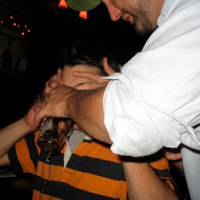
Note On Emerging Science: A Fix For Hiccups
/ Tivara TanudjajaView the page for this story
For most of us hiccups may be just an occasional annoyance, but they can greatly reduce quality of life for people suffering stroke and brain injury, and some chemotherapies can cause frequent hiccups. Now at last there may be a solid treatment. Living on Earth’s Tivara Tanudjaja reports on how researchers have developed a tool to help halt hiccup spasms. (01:30)
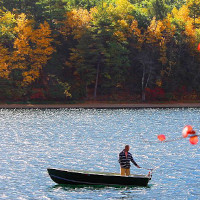
Beyond The Headlines
/ Peter DykstraView the page for this story
This week, Host Steve Curwood talks with Peter Dykstra, an editor at Environmental Health News, about the far-reaching consequences of climate disasters for many Americans. They also discuss the slow progress in replacing lead-contaminated pipes that provide drinking water to many homes in the Chicago area. Looking back in history, 30 years ago in September 1991 a developer dropped plans to develop Walden Woods as an office park, thanks to pressure from Don Henley of The Eagles and others. (04:23)

The Hummingbirds' Gift
View the page for this story
Hummingbirds are truly superlative creatures - relative to their size, they are both the world's fastest avians and have some of the longest migratory journeys of any creature. Sy Montgomery focuses on these incredible birds in her latest book, The Hummingbirds' Gift, where she looks back on her harrowing but rewarding time raising two orphaned baby hummingbirds alongside Brenda Sherburn LaBelle, an artist and hummingbird rehabilitator. Living on Earth's Bobby Bascomb visited Sy Montgomery at her home in New Hampshire to learn more. (17:10)
Show Credits and Funders
Show Transcript
210910 Transcript
HOSTS: Steve Curwood
GUESTS: Sharon Lavigne, Sy Montgomery
REPORTERS: Peter Dykstra, Tivara Tanudjaja
[THEME]
CURWOOD: From PRX – this is Living On Earth.
[THEME]
CURWOOD: I’m Steve Curwood.
Hurricane Ida and the fight for environmental justice in Louisiana’s Cancer Alley.
LAVIGNE: The chemical plants are really having a ball with this hurricane. They are out there polluting us even more. They have oil leaks on the sides of the big tanks. You pass by some of the places you can smell sulfur, you can smell all different kinds of chemicals and stuff in the air. They think no one is watching them right now.
CURWOOD: But the community is watching and fighting back. Also, hummingbirds are tiny but fierce, legendary in many cultures.
MONTGOMERY: The Spanish explorers called them resurrection birds. They said that to stay so pristine, surely they must die every night and be remade anew every morning.
CURWOOD: That and more this week on Living on Earth – Stick Around!
[NEWSBREAK MUSIC: Boards Of Canada “Zoetrope” from “In A Beautiful Place Out In The Country” (Warp Records 2000)]
[THEME]
Hurricane Ida Adds Misery To Cancer Alley,’ Part 1
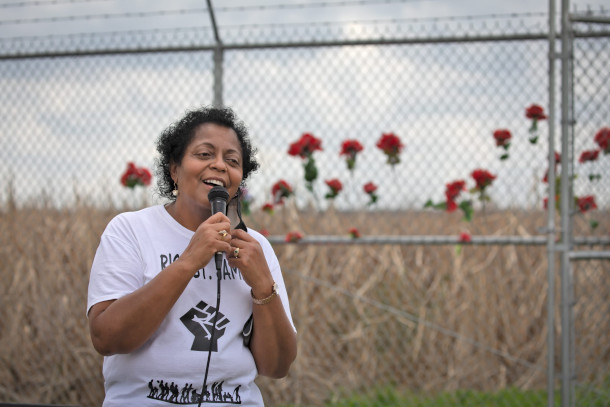
Founder of RISE St. James and 2021 Goldman Environmental Prize winner Sharon Lavigne speaks at the first annual African American Celebration at the gravesite of enslaved ancestors at the Buena Vista Cemetery. The land was purchased by Formosa for a proposed petrochemical complex. (Photo: Goldman Environmental Prize)
CURWOOD: From PRX and the Jennifer and Ted Stanley Studios at the University of Massachusetts Boston, this is Living on Earth. I’m Steve Curwood.
In a weird way it would be good news if the recent rash of mega-storms, floods, fires and drought are now the new normal. But the reality is the climate emergency is in a downward spiral, as President Joe Biden recently observed when he visited areas hit hard by Hurricane Ida and its aftermath.
PRESIDENT BIDEN: It’s just going to get worse and worse and worse because the storms are going to get worse and worse and worse. And so folks we have got to listen to the scientists the economists and the national security experts. They all tell us this is code red. The nation and the world are in peril. That is not hyperbole. That is a fact. They’ve been warning us the extreme weather would get more extreme over the decade and we are living in it in real time now. We can look around the wreckage the ruin and the heartbreak from so many communities to feel it you just understand it, you can feel it you can taste it, you can see it. Precious lives lost in Louisiana New Jersey and New York. Families in shelters. Subway stations flooded. Infrastructure pushed beyond the limits. Lives and livelihoods interrupted once again.
CURWOOD: The poor and disadvantaged are especially hard hit from big cities to places like former farmland along the Mississippi. This 85 mile stretch between Baton Rouge and New Orleans is called cancer alley and it’s the site of some of 150 petrochemical plants, a notorious source of toxic chemicals for locals on a normal day. But in the aftermath of Hurricane Ida many plants released even more pollutants than average as they dealt with high winds, high water and as much as 15 inches of rain. Many residents of this region are low income, descendants of the black slaves who once toiled on the vast sugar plantations of the lower Mississippi. Their efforts to come up from slavery included the purchase of land passed down through the generations. Many of those black families were already living in a hellscape for health before the storm ripped open their homes and bathed them with even more toxic water and air. Sharon Lavigne lives on land bought by her grandfather in St James Parish. She retired as a special education teacher to devote herself full time to advocacy as founder of RISE Saint James, an environmental justice group working to stop even more toxic industrial development in cancer alley. Her organization and others sued Formosa, a Taiwanese company that wants to build an ethane cracking plant nearby. That prompted the Army Corps of Engineers and the courts to require an updated environmental impact statement of the facility and earned Sharon the 2021 Goldman Environmental Prize for North America. Sharon Lavigne joins us now from Saint James Parish from her car, which is an air conditioned oasis in sweltering heat. Welcome to Living on Earth Sharon!
CURWOOD: Glad to be here with you all. I'm glad you can be. Thank you for taking the time with us. Where you are in St. James parish is one of the regions where hurricane Ida hit the hardest. Please take a moment to describe the situation there, your home and what's going on in your neighborhood.
LAVIGNE: Well, I live on the west bank of the Mississippi River in St. James Parish, and hurricane Ida, it just, it has so much destruction. So many homes have their roof off. Some of the homes are totally demolished. And when it came, it stayed here while it didn't move fast like it normally moves like hurricanes normally move. So this one was the worst I have ever experienced.
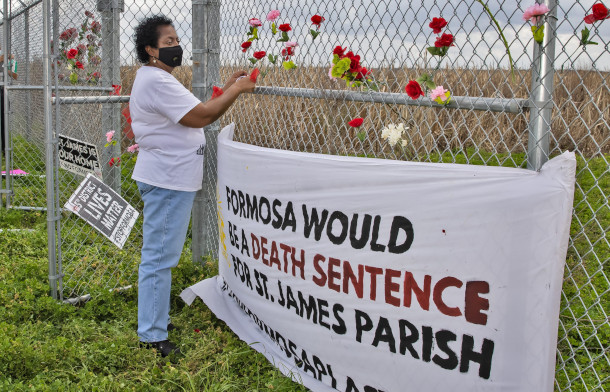
2021 Environmental Prize winner Sharon Lavigne joins community members in adding flowers to a fence around the Buena Vista Cemetery, the burial site of enslaved ancestors. The fence was erected by Formosa when they purchased the land for a proposed petrochemical complex. (Photo: Goldman Environmental Prize)
CURWOOD: What about your own home, Sharon, how are you doing?
LAVIGNE: My home is just about demolished. Almost half of the roof was taken off by Hurricane Ida. And inside of my home is totally demolished it’s really damaged bad. The ceiling fell and it was raining but the night of the storm it rained in my living room. And I have to get buckets and pour the water out every so often. And then in my den, I heard something falling, that was the ceiling. Then I heard something fall again. So I went upstairs. That was my son's room when he was living here when he was single living here. The ceiling just collapsed and they had water all over a wood floor. Then that morning I woke up, I went upstairs to the third floor, you can see the sky. Because the beams were not connected, they were open like and the rain was just pouring down just it just poured down. And the ceilings in there collapse. Everything in there is gone, the furniture, everything is gone. And then a few days later, I went back in the master bedroom, over half a room, the insulation, and the sheet rock is all on the beat, the carpet is wet. Everything is, I hope, I hope I can salvage the furniture, because that was my mother's bedroom set. And I hope I can save it but we have to get all the stuff all insulation and sheetrock off of it first, to see how much we can save. But I haven't had anyone to come and help me yet to get rid of all that debris around my house. And all that stuff is in my house. Because I was waiting on insurance companies so they could see it for themselves. Even though I have pictures of it. But I wanted them to see it themselves.
CURWOOD: One of the temperatures there now and how are you dealing with that? What about air conditioning?
LAVIGNE: None of that’s working. We don't have electricity right now. We don't have anything. We have somebody brought me some ice last night and we have bottled water, we have to put the bottled water on ice in our coolers. So the water is cold. But we had a time to get the ice. Our public officials I don't know what they are doing. I really don't know because nobody come to us and let us know what's going on. And first of all, we don't have the phone service where we could look at our phone and see what's going on because we don't have the service.
CURWOOD: Sharon, I understand you're the founder of RISE St. James. That's its a grassroots environmental organization. You mobilized against this twelve and a half billion dollar plastics manufacturing plant. Now what kinds of toxic pollutants where they go into release? What were the chemicals involved?
LAVIGNE: Benzene, benzene is one and that's cancer causing. Formaldehyde. There's a whole bunch of chemicals, a whole lot of greenhouse gases that they're going to release in the air and into the water.
CURWOOD: I understand that that plant was going to make something called MDI.
LAVIGNE: Yes, they make throwaway plastics, straws, cutlery, like the plastic forks and spoons and plastic plates, all of that a whole lot of plastic. But in the meantime, doing it, they want to pollute us to get it to be made. They are gonna pollute the air even more. Even though we have twelve refineries and industries in the fifth district where I live. They don't care. They want to add some more to us. So once they add this industry to us, we're not going to be able to live. It's going to be too much in the air for us to breathe and live. We are having trouble breathing. Now we have people with asthma. We have people with all all types of respiratory illnesses. We have people with cancer all up and down this river. And they wanted to pollute us even more because I guess they figure that we're the area where they dump the garbage. And our governor approved this industry. Our parish officials approved this industry and they live here in St. James. That's the part that hurt me, because they live here with us. But they think because it's in the fifth district on the West Bank, they think it's not going to go to the other districts. But it will go to the other districts, it will not get to them as fast as is getting to us. But eventually, just like we would die off from this industry, they would die off too. It's hurting. It's a hurtful thing to think how people just want to throw something on us because we are black and we are poor. And no one would speak up, no one would speak up against industry, because industry have more money than we have. So in some cases, money talk. But I don't care if I don't have any money. I'm going to fight for my community. And this is where I've been all my life. And this is where I want to stay. And I have people in this community that's backing me up.
CURWOOD: What about the location of this plant that does the MDI and the other chemicals? Where is that in your neighborhood?
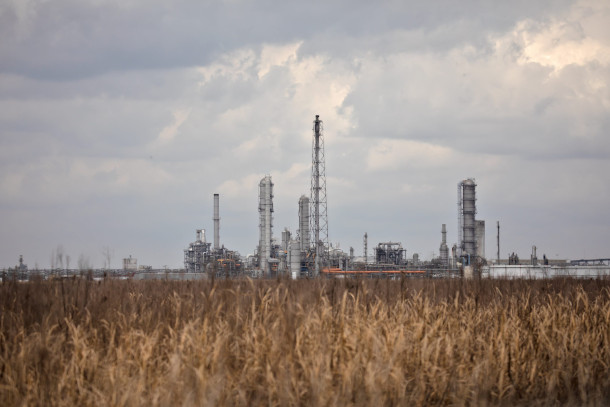
The Dow Chemical Company facility near the Mississippi River in Hahnville, Louisiana. (Photo: Goldman Environmental Prize)
LAVIGNE: This plant would be two miles from my home. It would be one mile from a church and a school, public school. And that's when I said no more. Because I didn't know that all of these industries, I didn't know how many we had to be honest with you. Until I went to a community meeting. And when I went to that meeting, I found out so many things that were going on, and all the chemicals and the people that were sick. One lady was on oxygen and she had cancer and she not even try to fight industry. So I said, I asked them, “Why don't we fight from Formosa?”. And they said, Oh, the governor appproved that. And they said the parish council is gonna approve it too and once they approve it, it's a done deal. There is nothing you could do about it. And I told them, we need to do something about it because we have, we have too many. And they said oh Sharon you are wasting your time. You can't fight industry. So that's when I pray now with the god I left them fools alone. And I went to God and I prayed and I asked God what I should do. And he told me to fight. So that's when I started to fight. I didn't know what what to do to fight. I didn't know how to do this, this type of thing because I was never involved in involved in environmental issues, I was never involved in anything in the parish. We formed RISE St. James in October of 2018. Then we started meeting other organizations in New Orleans and different places, in that we formed a coalition and we called it Coalition against Death Alley.
Then we had a march in 2019 May, the end of May to the beginning of June, we marched for five days, from Reserve to Baton Rouge. Then in October, we had a march for 10 days, it was tiresome, but we went, we did it. We lit candles for the loved ones, who died of cancer, I still have those panels in my in my garage. When we went to the Capitol to see the governor, he wouldn't even come out. And he knew we were there. And the Secretary would come out and say oh, he's got to come, all this, giving us lies and stuff. He never came out. I was told he went out the back door. That's what I was told. I didn't see that but I was told that. And then when the governor came down here in 2019, November 1st a Friday, I wasn't teaching school because I retired in October. So I went to this event, because he was soliciting votes. He needed the African American votes. So we packed that building and I had my rice and gym shirt on me and two other people. The other members said they weren't gonna wear this shirt. They want to go dress up for a governor. And I said, I don't want to dress up for a governor, I want the governor to see me to let him know who we are. And we don't like the idea that he want to put this industry in our community. But they don't think like that. They want to take a picture with the governor. I don't want a picture with the governor. So when somebody came to me, and asked me if I will speak to the governor, I said, Sure, I sure would. They didn't have a problem finding me because they saw me with their shirt on.
I said governor I would like you to stop Formosa. Don't let it come into our neighborhood. And this is what he answered me. I'm going to do a health study.
CURWOOD: A health study. He is going to study the problem. He's not going to take action.
LAVIGNE: I was so hurt. I was so let down because he just threw it off like it was nothing. So I guess to let the people that called him know that he did speak to me. Then after that he walked away.
CURWOOD: So eventually you filed lawsuits against the Formosa plant. What happened with those lawsuits?
LAVIGNE: They still in there, they’re still pending. One of the judges, the district judge told EPA to go back and use recent data. When Formosa wants to come in they didn't evaluate all of the industry that's already here. They just tell what Formosa was going to be emitting in the air. So that's when we say this area can't take anymore. We already bombarded with too much emissions. So that's when the judge Trudy White all EPA to go back and come back with more recent data.
CURWOOD: Our guest is Sharon Lavigne, founder of RISE Saint James and the 2021 Goldman Environmental Prize winner for North America. We’ll continue our conversation after the break. Keep listening to Living on Earth.
Related links:
- Learn more about RISE St. James
- CNN “What a hurricane means when you live in Louisiana’s Cancer Alley”
- Learn more about Sharon Lavigne the 2021 recipient of the Goldman Environmental Prize
[MUSIC: Sam Lightnin' Hopkins “Cotton”]
ANNOUNCER: Support for Living on Earth comes from Sailors for the Sea and Oceana. Helping boaters race clean, sail green and protect the seas they love. More information at sailors for the sea dot org.
[CUTAWAY MUSIC: Archie Shepp & Horace Parlan, “When Things Go Wrong” on Trouble In Mind, by Robin Lane with Joanne Cipolla, SteepleChase]
Hurricane Ida Adds Misery To ‘Cancer Alley,’ Part 2
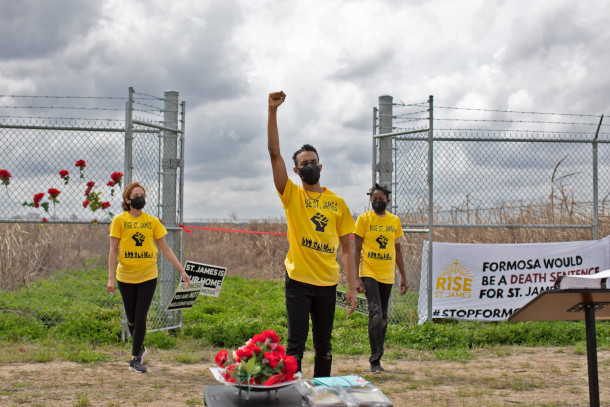
Community members at RISE St. James’ first annual African American Celebration at the Buena Vista Cemetery, the gravesite of enslaved ancestors. (Photo: Goldman Environmental Prize)
CURWOOD: It’s Living on Earth, I’m Steve Curwood.
Before the break Environmental Justice activist Sharon Lavigne told us how Hurricane Ida added even more misery to the toxic environment she and her fellow residents endure along the petrochemical corridor in Louisiana known as Cancer Alley. Sharon is the 2021 North American Goldman Environmental Prize recipient for her work that so far has blocked construction near her home of a major ethane cracking plant proposed by Taiwanese plastics maker Formosa. But a lifetime of exposure to toxic chemicals has already killed some and sickened many others in the region, including Sharon herself.
LAVIGNE: In 2016, I was diagnosed with autoimmune hepatitis. And I found out that it came from industrial pollutants. And then in 2018, I was diagnosed with aluminum in my body. And this year, I was diagnosed with lead in my body.
CURWOOD: Now this land that you live on, this is a family place, if I understand that correctly.
LAVIGNE: Yes it is. It's my grandparents'.
CURWOOD: So that was old sugar cane plantation land north of New Orleans there on the west bank of the Mississippi.
LAVIGNE: Yes, it was. We still have a few people doing sugarcane. But the industry have bought a lot of the sugarcane land because they want that land for industry. And a lot of people sold their land to industry because it's more money. It's more money than they selling it to a resident.
CURWOOD: So when a hurricane is about to hit as part of the emergency procedure petrochemical facilities have apparently the right to emit unprocessed chemicals and gases through flaring, which is basically burning them in the air. So how has this impacted the community during Hurricane Ida? What happened with stuff from the chemical plants?
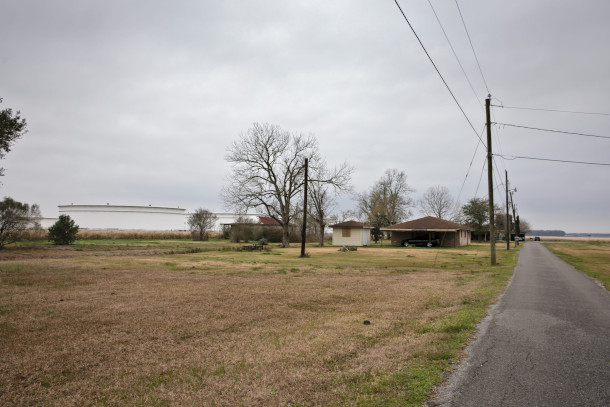
Oil storage tanks in St. James Parish, Louisiana. (Photo: Goldman Environmental Prize)
LAVIGNE: The chemical plants are really having a ball with this hurricane, they are out there polluting us even more. Before Ida they the flares were in the air, and it might have stopped might have vented it like on a morning or an evening. Now it's constant all day long and the reason why I know I live two miles from it, two and a half miles from it. And I pass there and other people pass there and they tell me and I did live stream for two or three days about this industry that's with the flares. They have oil leaks on the side of the big tanks in St. James in a little area called Burton Lane. I went out there for two days to take videos and to do live streams to let the people know what's going on in St. James because the industry doesn't care. They really don't care if they are polluting us. If you pass by some of the places you can smell oil, you could smell sulfur. You could smell all different kinds of things in the air, different chemicals and stuff in the air. So they’re having a ball. They think no one is watching them right now. So they're polluting us even more on top of the hurricane, they are taking advantage of that and they are polluting us even more.
CURWOOD: What’s the chemical plant that's two and a half miles away from you that is operating right now?
LAVIGNE: American Syrinix and Mosaic. Mosaic is a fertilizer plant and they have sulfur sitting up there and you could smell it when you pass by. One lady came from Lake Charles she came to bring supplies and she was going towards, gonna jump across the ditch to go on top of the levee. As she stepped some oil, she stepped in oil. They put the oil in a ditch. They don't care. They put oil in Burton Lane. Marathon it was was Shell before they change the name to marathon. So they polluting those people right in Burton Lane. You have poor black people don't have no don't have no white people in Britain. People are dying, two people died over there. One guy with respiratory problems because he can walk a few steps and go past the tank. That's how close one of the tanks are to his house, and he died. And this other lady that was fighting with me she died to, she had all kinds of problems, all kinds of illnesses. Her house would shift when they built a train, the rail and everything, her house would shift. They started to have flooding because the plant built a levee to keep the water from coming on their side. And the water came on the residence side. And they have this noise all day long. And they have this fuming air all day long. And these people were bombarded with all of that all throughout the day. They call me and complain. And the lady that was helping me she died.
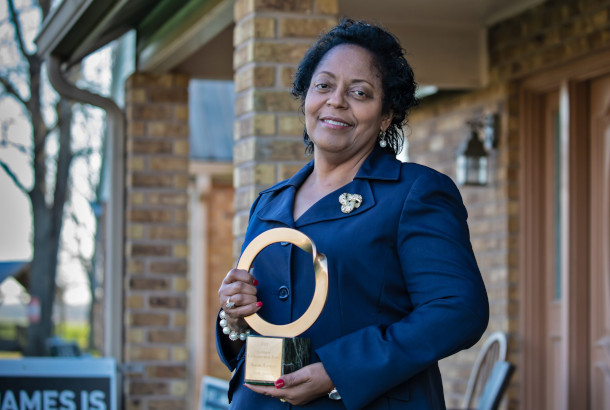
Goldman Environmental Prize winner Sharon Lavigne with her award in the shape of an Ouroboros at her home in St. James Parish. (Photo: Goldman Environmental Prize)
CURWOOD: We’ve seen statistics that say that people in cancer alley are dying five times more often of COVID of the virus than the national average. What have you seen along those lines yourself?
LAVIGNE: I’ve seen a lot of people that died with COVID. I've seen more In fact, St. John Parish, I heard about more over there than over here in St. James. St. James have a lot too but St. John the Baptist have the most that I know of. And the cancer rates are very high in ‘cancer alley’. In St. James. We have so many people with cancer. So many people, I would have to take a long tablet to write down all the names of the people that I know that died of cancer and the people who have cancer right now. I have relatives with cancer. I have a sister in law that died with cancer. Two neighbors died one on each side died with cancer. I do have people over here that I can give you their number you can talk to them and they can tell you the kind of cancer their husbands had, husbands died with cancer. And one man was working in a plant he died with throat cancer. I don't understand it. I really don't.
CURWOOD: Sharon Lavigne, thank you so much for taking this time with us and we wish you well for the recovery from Ida and from living in this ocean of pollution.
LAVIGNE: Yes, thank you, thank you for having me. But I like the way you put that, the ocean of pollution. You are right it is it is the ocean of pollution. We can't even drink the water. The water is contaminated. And we are under a boil water advisory right now. It’s sad, it’s really sad, it's hurtful. It's really hurtful and our children have to grow up in this. And when you move to the next town, it's not it's not much better. From Baton Rouge to New Orleans. That's what they call cancer alley. It’s sad it makes you want to cry. I've cried many days. When I found out about all these industries, I didn't know it was that bad until I started doing this work. When I found out I said how can the people sit in here and let this happen.
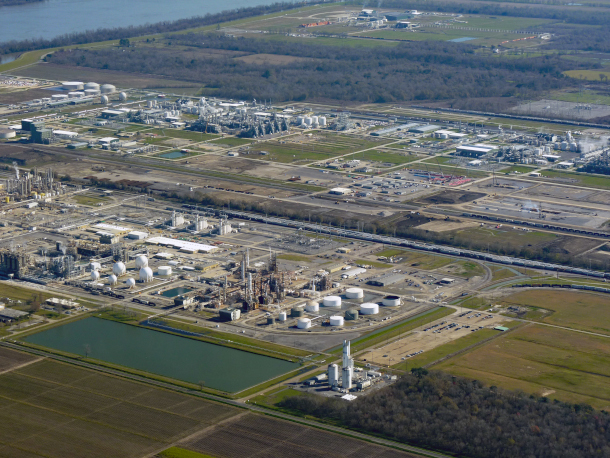
Part of the Dow petrochemical industry complex on the west bank of the Mississippi in Iberville Parish. (Photo: Louisiana Sea Grant)
Didn't even try to fight to try to stop it. A lot of them are afraid a lot of them have people that work in industry. I had two brothers that are worked in the industry, have a daughter that worked in industry, but it doesn't mean you have to pollute us and kill us and poison us. It hurts me to know that people are afraid to speak up. Some of them speak without the camera. I don't care if I have a camera, I don't care what it is, I’m gonna speak up. And they’re afraid for me. I'm not afraid for me. I'm afraid they'll be going to die of all these chemicals and nobody do something about it. And it hurts. It hurts so bad, it really does. And I’m gonna keep on speaking up, I’m not gonna stop. The industry will tell you they stopping but they lie. And they still pollute you. They do it a different way without you knowing, but you could smell that stuff. And I'm gonna fight.
CURWOOD: Our guest has been Louisiana resident and Hurricane Ida survivor Sharon Lavigne, the founder of RISE Saint James and the 2021 Goldman Environmental Prize winner for North America. A spokesperson for the Formosa Plastics Group told New Orleans Public Radio the company will comply with any directive to assess potential impacts of the project, and cited the company’s “unwavering commitment to the parish and to Louisiana.” Marathon Pipeline acknowledged a release of crude oil the day after Hurricane Ida. The company said it is cleaning up the spill and claims there were “no identified offsite impacts.”
Related links:
- Rolling Stone | “Hurricane Ida Pounded Louisiana’s ‘Cancer Alley’ It’s Residents Need Help and Demand Change”
- The Guardian | “Louisiana’s Shell Refinery Left Spewing Chemicals After Hurricane Ida”
[MUSIC: Buddy Guy, ‘Slow Blues (Instrumental)” on Downtempo Blues Instrumentals, X5 Music Group]
CURWOOD: Your comments on our program are always welcome.
Call our listener line anytime at 617-287-4121. That's 617-287-4121. Our e-mail address is comments at loe dot org. - comments at loe dot org. And visit our web page at loe dot org. That's loe dot org.
[MUSIC: Buddy Guy, ‘Slow Blues (Instrumental)” on Downtempo Blues Instrumentals, X5 Music Group]
Note On Emerging Science: A Fix For Hiccups
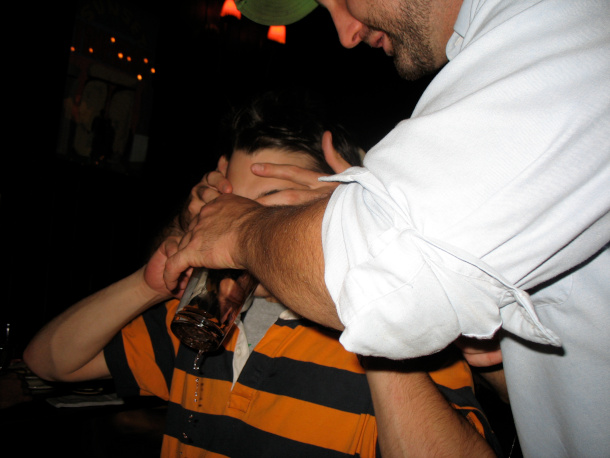
There are many home remedies for “curing” hiccups, though they are rarely backed by science. Pictured is a hiccuper drinking water while others cover his ears. (Photo: Radrice, Flickr, CC BY 2.0)
CURWOOD: Just ahead we’ll have our weekly trip beyond the headlines but first this note on emerging science from Tivara Tanudjaja.
[SCIENCE NOTE THEME]
We all have our own theories on how to cure hiccups, like breathing into a bag, getting surprised or holding your breath for a time…
They don’t always work for everyone, but researchers from The University of Texas Health Science Center at San Antonio have found something that might just do the job.
They have created a science-based intervention for hiccups called the Forced Inspiratory Suction and Swallow Tool.
It’s a drinking tube with a valve that requires forceful suction to draw water from the cup and into the mouth. It’s much like trying to drink through a blocked straw. And by stimulating the phrenic and vagus nerves, the suction and swallow action ends the “hiccup spasms.”
According to their survey, the drinking tube helped stop hiccups in nearly 92% of cases.
For most of us, hiccups are an occasional annoyance, but for others, hiccups can greatly reduce quality of life. For example, some chemotherapies can cause frequent hiccups. Researchers hope the tool will help cancer patients as well as those suffering stroke and brain injury.
Although the drinking tube must still undergo clinical trials, researchers are hopeful the tool would help with both the occasional and frequent hiccups. They hope to scale up and make it available to the public in the near future.
That’s this week’s note on emerging science, I’m Tivara Tanudjaja.
Related link:
EurekaAlert! | “Team Describes Science-Based Hiccups Intervention”
[SCIENCE NOTE THEME]
Beyond The Headlines
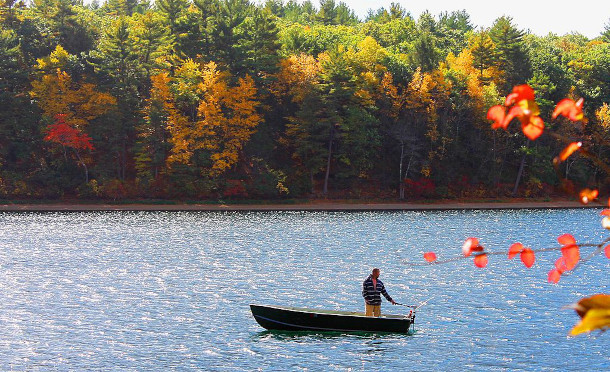
Walden Pond in the fall. (Photo: Terry Ballard, Wikimedia Commons, CC BY-SA 4.0)
CURWOOD: Well, it's time for us to take a look Beyond the Headlines now with Peter Dykstra. Peter is an editor with Environmental Health News that's ehn.org and DailyClimate.org. On the line now from Atlanta, Georgia. Hi there Peter, what do you have for us today?
DYKSTRA: Well, hi, Steve. We just read about an analysis done by the Washington Post, who tallied up that one in three Americans live in a county that experienced a weather disaster this year.
CURWOOD: I'm surprised that number is so low. It feels like we've all been hit by crazy weather this summer.
DYKSTRA: Well, yeah, and if you run through the list of things that we've often called natural disasters, but now we know that they are at least influenced by climate change, and are, therefore, at least partly man-made disasters. You've got Hurricane Ida and other storms. Ida is doing terrible damage in Louisiana, then causing flooding up through the Northeast. If you go west, it's not rain, but drought in so many places. Those droughts helped inspire another climate calamity in wildfires. And that wildfire smoke is almost in every corner of the country; drifting all the way to the east coast, causing serious air pollution problems in cities like Denver, which has been lucky enough not to have any huge wildfires this year. But they still have the impact.
CURWOOD: And I think almost everywhere in the east, you haven't been able to see stars at night because there's so much smoke in the air. Hey, what else do you have for us today?
DYKSTRA: Mayor Lori Lightfoot set a goal this year for Chicago to replace 650 toxic lead pipes leading into homes; part of the nationwide scandal about lead pipe drinking water. So far out of those 650, according to the Chicago Tribune's Michael Hawthorne, they've removed three. And not only is three out of 650 a pretty lousy performance by any standard, those 650 were very modest goals to begin with because Chicago has an estimated 400,000 lead-contaminated pipes leading to residences throughout the city.
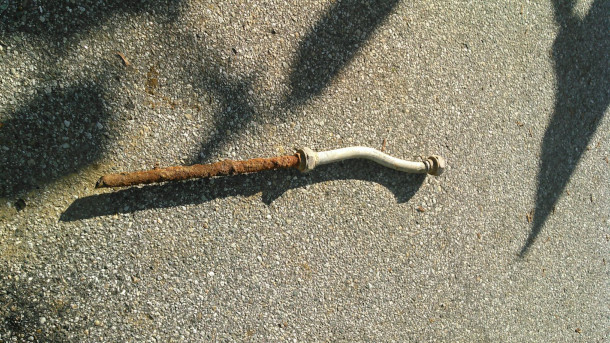
A lead gooseneck pipe that is typically found in old infrastructure. Without being replaced these pipes contaminate drinking water, making the it toxic and unsafe to consume. (Photo: Courtesy of Office of Ground Water and Drinking Water, United States Environmental Protection Agency)
CURWOOD: So if you did three a year, or there's more to the year left, maybe four a year to get the 400,000. I mean, you're talking 100,000 years. Something has to change. What about other cities?
DYKSTRA: There are other cities doing a much better job suggesting that Chicago could be doing a better job as well. There are cities like Detroit with the same aging infrastructure, and Denver a little bit smaller, a little bit newer. They are doing the pipe removal for half the price Chicago says, and they've already replaced thousands, not three. Chicago, if they do that four a year which of course is ridiculous, but if that pace remains, even the Chicago Cubs will have won another World Series before the pipes are clean.
CURWOOD: Alright, let's take a look, now, back in history for a moment, and tell me what you see.
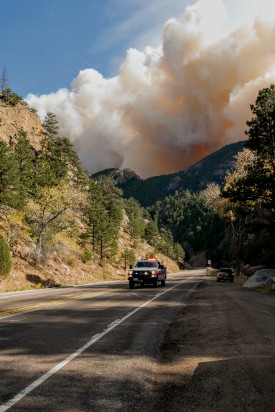
The Calwood wildfire in Colorado shows the massive smoke plumes that can eventually spread across states. (Photo: Malachi Brooks on Unsplash)
DYKSTRA: 30th anniversary, September 17th, 1991, the millionaire developer and publisher, Mortimer Zuckerman, who became too many environmentalists a real villain by financing a proposed office park not far from the edge of the Walden Woods and within view of Henry David Thoreau's cherished Walden Pond; the inspiration for one of the first seminal environmental books in our nation's history. On September 17th, '91, due to pressure from environmental groups led by Don Henley, the drummer for the Eagles, Zuckerman threw in the towel, pulling out his money, effectively ending the threat to Walden Pond and Walden Woods.
CURWOOD: We can thank rock'n'roll for helping to save this eco icon for us.
DYKSTRA: That's right. Don Henley and many, many other people scored a victory for Henry David Thoreau's legacy.
CURWOOD: All right, Peter, thank you so much. Peter Dykstra is an editor with Environmental Health News that's ehn.org and DailyClimate.org. We'll talk to you again real soon.
DYKSTRA: Okay, Steve, thanks a lot. Talk to you soon.
CURWOOD: And there's more on these stories on the Living on Earth web page, that's loe.org.
Related links:
- The Washington Post | “Nearly 1 In 3 Americans Experienced A Weather Disaster This Summer”
- Chicago Tribune | “Mayor Lori Lightfoot Set A Goal To Replace 650 Toxic Lead Pipes In Chicago In 2021. So Far, 3 Have Been Removed.”
- Deseret News | “Publisher Quells Controversy by Selling Walden Woods Tract”
[MUSIC: The Eagles, “Hotel California” on Hotel California, by Don Felder-DonHenley-Glenn Frey, Asylum]
CURWOOD: Students are heading back to school but they aren’t the only ones hitting the books this fall. A new season of the Living on Earth Book Club gets started in less than 2 weeks. First up in our series is a conversation Richard Powers, the Pulitzer Prize winning author of Overstory, about his new book Bewilderment. It’s a novel about an astrobiologist raising his son as a single father on a beautiful, imperiled, planet. And if you have a question for Richard Powers please email it to us in advance at loebookclub@loe.org. That’s loebookclub@loe.org. Please join us online for this event Thursday September 23 at 7:00 pm eastern. To register visit our website, loe dot org slash events. That’s loe dot org slash events. There you can also learn about the rest of our fall lineup for the Living on Earth Book Club.
CURWOOD: Coming up – Talk about tiny! Daring to raise baby hummingbirds. That’s ahead on Living on Earth.
ANNOUNCER: Funding for Living on Earth comes from you, our listeners, and United Technologies, combining a passion for science with engineering to create solutions designed for sustainability in aerospace, building industries, and food refrigeration.
[CUTAWAY MUSIC: Edgar Meyer, “The Low Road” on Edgar Meyer, by Edgar Meyer, Sony Classical]
The Hummingbirds' Gift

Sy Montgomery’s newest book, The Hummingbirds’ Gift: Wonder, Beauty, and Renewal on Wings . (Photo: Courtesy of Sy Montgomery and Simon & Schuster)
CURWOOD: It’s Living on Earth, I’m Steve Curwood.
As days grow shorter during fall in North America the instinct to migrate arises among many birds, including the smallest of avians, the hummingbirds. Nature is calling them South towards Central America. And what these tiny birds lack in size they make up for in vigor, with a heart rate of more than 1200 beats per minute and up to 70 wing flaps per second, depending on the species. Writer Sy Montgomery had the opportunity to help raise two baby hummingbirds alongside a hummingbird rehabilitator. She wrote about the experience in her latest book titled, The Hummingbird’s Gift: Wonder, Beauty, and Renewal on Wings. Living on Earth’s Bobby Bascomb visited Sy at her home in New Hampshire where she asked her what is the hummingbird’s gift?
MONTGOMERY: Well, the hummingbirds' gift is the gift that they gave to us. These were two orphaned baby hummingbirds who were just a few days old when they came into the hands of Brenda Sherburn LaBelle, who's a specialist hummingbird rehabilitator, but in rehabilitating them, in saving their lives, in being able to let them go free as adults, the gift that they gave us was giving us a hand in resurrection. They would have died, they came back from the dead, and to be able, essentially, to restore these amazing little birds to the sky. These birds that are superlative in so many ways, to have a hand in making that happen, is enormously empowering and inspiring. And particularly right now, you know, we've been through this pandemic and terrible period of environmental catastrophe and racial unrest and political upheaval. It's so good to have a story like this of a small miracle, reminding us that we can have a hand in restoring life.
BASCOMB: How did you get started with Brenda and the hummingbirds?
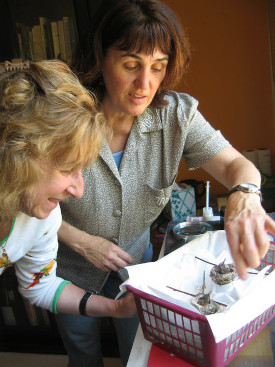
Brenda Sherburn LaBelle (rear) and Sy Montgomery (front) look at Zuni and Maya in their nests. (Photo: Courtesy of Sy Montgomery)
MONTGOMERY: I was actually writing an earlier book about birds. And each chapter in this book, which is called Birdology, was looking at a different aspect of birdiness. And one of the things about birds of course, is that birds are made of air and hummingbirds are the ones who illustrate that best. You know, most birds, their feathers outweigh their skeletons because their bones are hollow. Their bodies are filled with air sacs, a hummingbird has no fewer than nine big air sacs. And that's in addition to two huge lungs, and a giant heart. They are so air filled, that even giving them an injection, if they're sick, can pop an air sac and kill them. But it's this very fragility, the fact that they are little more than bubbles cloaked in these iridescent feathers, this is what gives them their superpowers of super flight. Because only hummingbirds can hover alone among birds, it may look sometimes like a seagull, for example, is hovering, but it's not really hovering. These guys can just hover in the middle of the air for minutes. And not only can they perform this acrobatic feat, but they're also per body length, a hummingbird is the longest migrant of all the birds in the world. It's because you know, it's so small. And if you're looking at the number of body lengths that it can travel, you know, flying from Alaska to Mexico, for somebody who's just a couple inches long. Imagine what a feat that is. And also they're superlative, in that they're the fastest birds in the sky, if you look at per body length. In fact, they travel faster in terms of body length through the sky than even the space shuttle when it screams down through the atmosphere. So these birds are supremely gifted with these amazing powers. And they owe all those powers to the very thing that makes them most vulnerable and fragile.
BASCOMB: It’s amazing. And so your friend, I think Brenda said, hey, I have these two hummingbirds. Can you come help me? And you said, I'm on a plane! I'll be there!
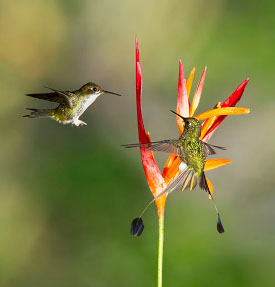
Booted Rackettail Hummingbirds (Photo: © Tianne Strombeck)
MONTGOMERY: Yeah, absolutely. I found Brenda. I mean, she's a friend of a friend. And the minute I met her, it was one of those wonderful things that you know, like, I want this person to be one of my best friends for the rest of my life. I mean, her kindness, her patience, her attention to detail, the fact that she was so dedicated. This is a really demanding thing to take care of these tiny little birds, it demands that every 20 minutes, from dawn to dusk, everything must stop because if you don't feed them every 20 minutes, they will starve. And you have to feed them exactly the right food and exactly the right amount. If they don't get enough, they'll starve but worse if they get too much, remember, they're little bubbles. They're made of air, they can pop and she's an artist. She's a sculptor. And you can't do any sculpting while you're taking care of an orphan baby hummingbird. So I so admired her and I was delighted to be able to help her and document what she was doing. So when these two little orphans showed up, she called me up. I got on the plane. I flew out as fast as I could.
BASCOMB: And you became a 24 hour a day nurse to these baby hummingbirds. Can you give us a little insight into a day in the life of a hummingbird rehabilitator?
MONTGOMERY: Yeah, you bet. First light, you got to be up, because that's when the hummingbirds get up. It's a little before dawn. And while normal people are grinding coffee, what we're grinding is fruit flies, because many people don't realize that hummingbirds need hundreds of insects to eat every day, in addition to nectar. So we're grinding up these frozen fruit flies with a mortar and pestle. And then we're mixing up the special elixir of nectar and vitamins and minerals and enzymes, and fixing it up. And the stuff, you can't just mix up a big batch and use it for the rest of the week. It goes bad very quickly. So we're fixing that up, we put it in a syringe. And then you've got attached to the syringe, this long tube, and you got to stick that down the infant's throat, which terrified me, because you know, they're so tiny, that even touching their feathers can damage their feathers, there's so little there, their feet are like embroidery thread, you know. And at first, I just was terrified, I'm going to hurt them. But every 20 minutes, we had to feed them. In addition to that, you wanted to make sure that they stayed clean. And we had to patrol against some of the dangers that can afflict hummingbirds, including different kinds of mites.
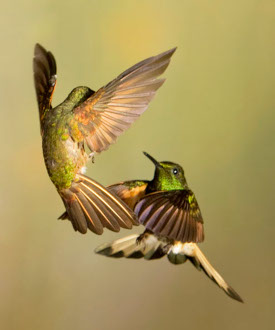
Two hummingbirds hover in the air. (Photo: © Tianne Strombeck)
BASCOMB: Yeah, a really kind of poignant part of your book is when when they get mites, and you have to treat them from mites. And one of them I believe you had to treat twice. And it sounds just so nerve racking.
MONTGOMERY: Oh, it was so awful. Oh my gosh, it was terrible. There's some hummingbird mites that are beak mites. And they they just, they're on your beak, you go to a flower, they transfer to the flower and everything is fine. But there's other mites that will suck your blood and make you itch and drive you insane. And they can kill them. And so we tried to get them off just by very gently trying to wipe them off with a q-tip. But there were too many. We took the little nest that they were in. And while we held the birds in our hands, we nuked the nest in the microwave, and dozens and dozens and dozens of horrible mites fell out. And we realized, oh my gosh, this infestation is really serious. We're going to have to treat them with insecticide. And as you know, you know, all insecticides can be lethal. And you've got to use just the right amount. And you also have to dip the birds in water, which they hated. And they peeped terribly after we applied the insecticide. They just sat there listlessly trying to recover from this and we could have killed them. It was horrible. We did not know, for many, many minutes if they were going to survive this. And it was during that time while we were waiting to see if they would recover from this treatment, that we finally decided to go against one of the things a lot of rehabilitators say they'll never do. And that is to name their charges. But we decided during that interval, that we loved them so much. They were individuals to us. And we named them we didn't want to just call them the big one and the little one. And that's when we named them Maya and Zuni. And they both survived.
BASCOMB: And what are the origins of those names?
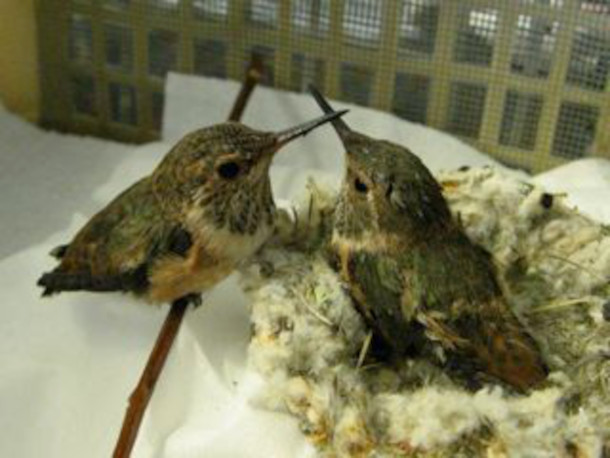
Maya and Zuni. (Photo: Courtesy of Sy Montgomery)
MONTGOMERY: Well, we actually had a lot of contenders. At first, I wanted to call the older one Aztec, because the Aztecs really admired hummingbirds, and they adorn statues of Montezuma with their feathers. But the Aztecs were too violent for Brenda. So she said something else. So what we decided on was for the larger bird, Maya, because the Mayans believed that hummingbirds were made from scraps left over when God created the other birds. Isn't that lovely? And those brilliant colors were a parting gift from the sun god. So Zuni, we named because like the Hopi and the Pima people, the Zuni believed that hummingbirds bring rain and we desperately needed rain. We needed a miracle.
BASCOMB: Yeah, you talk in your book that there's a lot of ancient cultures and traditions that have this association with hummingbirds and you're just talking about how tiny and how fragile and how very delicate they are, which of course they are. But they also have this association in other cultures of being this fierce warrior. Can you talk a bit about that?
MONTGOMERY: Yeah, they really are fierce. And if you have a hummingbird feeder, you've seen a hummingbird chase every other hummingbird away from the feeder that they insist is theirs. And people who've studied what hummingbirds do with their time have found that an individual hummingbird spends far more time chasing everyone else away from his feeder, even though there's plenty for everyone, far more time doing that than actually sipping or licking up the nectar themselves. So they do fight furiously and sometimes they'll just fall to the ground locked in combat. But the story that I love about the hummingbirds is one that the Spanish made up pretty much to explain how they could remain so gloriously beauty beautiful and pristine and, and how they could glitter so brightly. And these Spanish explorers called them resurrection birds for that reason. They said that to stay so pristine, surely they must die every night and be remade anew every morning.
BASCOMB: Wow, that's a beautiful sentiment. And at the same time that Aztecs, their god of war was actually a hummingbird.
MONTGOMERY: Yes. And I know it sounds like jeez, you know? That's kind of like the New Zealand Air Force has a flightless bird on its planes but, but really for ferocity, for tenacity, for strength, for maneuverability, agility, you can't do better than a hummingbird.
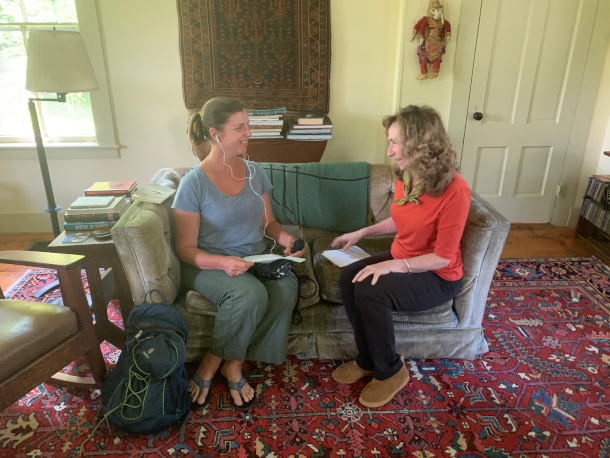
Bobby Bascomb (left) meets with Sy Montgomery (right). (Photo: Jay Feinstein)
BASCOMB: Yeah, it's amazing. I was looking at some pictures as I was getting ready for this interview. And if you look at a real close up of the beak of some species of hummingbird, it looks for all the world like a sword. Like a serrated sword. You know, if that was at any scale, it would be a really dangerous weapon, you can easily see why they're so fierce.
MONTGOMERY: Yeah, they totally will spear each other too. They want to.
BASCOMB: Do you have any favorite memories of your time with Zuni? And Maya? Perhaps that's an unfair question. But is there one that you really come back to and think of, you know, a poignant moment for you?
MONTGOMERY: Oh, there's so many, but one in particular that stands out, Maya was let go first, because typically, they are laid couple of days, the eggs are laid a couple of days apart, and you always have one bigger and one smaller hummingbird. So when we let Maya go, oh, it was so scary. We expected to see Maya again and waited, and waited and did not see him. Well, of course, he needed to feed. And every time he tried to come near a feeder, all these other adult hummingbirds chased him away. But what did he do? He came and got us. He came and got us. And we could actually go out and hold a feeder in our hands, that the other hummingbirds were afraid to approach. And he would feed directly from our hands.
BASCOMB: Wow, what a special memory to be able to hand feed a hummingbird.
MONTGOMERY: Yeah.
BASCOMB: So what should a listener do if say they find a, you know, abandoned hummingbird nest with a few orphans in it?
MONTGOMERY: Yeah, the first thing to do is to make sure that they're really abandoned. And wildcare is quite adamant about this, you need to watch for at least 30 minutes and not take your eyes off that nest to make sure that the nest really has been abandoned by the mother because the mother makes between 10 and 110 trips every day to get enough bugs and nectar to feed her babies. And she comes back and is gone in an instant. So make sure that you don't take your eyes off that nest. A lot of people are bringing in nests that aren't abandoned. And it's very hard to raise these, these little babies. But if you do find that the hummingbird nest has been abandoned, look up in your state wildlife rehabilitators and look to see who does birds and call the closest one. And as soon as you possibly can get the bird over there. If you find the nest in the evening and the place is closed, just make sure that it's not like on the ground so a cat is going to get it. You might want to try to take it inside and keep it warm, but do not try to feed or give any water to them. People feed these things the weirdest stuff, people who are trying to help and you think, you know, thank you for caring but particularly if it's an orphaned baby hummingbird, they need very particular precisely calculated food. So bring it to a rehabber and they will be delighted to take over.
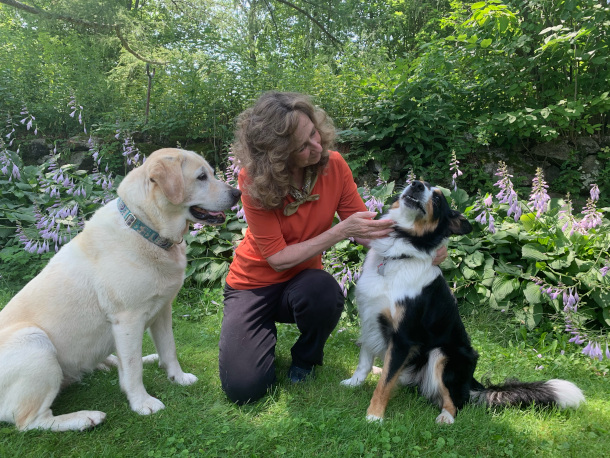
Sy Montgomery with her dog Thurber (right), as well as a friend’s dog (left). (Photo: Jay Feinstein)
BASCOMB: Leave it to the experts.
MONTGOMERY: Right.
BASCOMB: How did it feel for you when you finally released them? I mean, this is a labor of love, but it had to be kind of draining at the same time. You know, every 20 minutes. You got to feed these guys and also the exhilaration of seeing them finally, healthy enough to leave you.
MONTGOMERY: Yeah, It's bittersweet, you know. It's a hard world out there. You see all these bully hummingbirds, you know, that are chasing your baby away. But of course, you know, they're just doing what they have to do to survive themselves. But you've put so much love and care and time into these tiny little fragile lives, and you let them go. And within days, they're flying to Mexico. And your heart just goes with them.
BASCOMB: Beautiful. What do you hope that readers get out of your book?
MONTGOMERY: I hope that they see that miracles happen all the time, and that we can take a hand in them. And that even in small ways, we can heal the problems that are besetting our Earth. The hummingbirds to me, are a great symbol of hope. Because after all, you know, it's their fragility and their vulnerability that gives them their strength. And right now, so many of us are feeling vulnerable and fragile, and we don't know what's ahead. But if you look at a hummingbird, and what it's able to accomplish, the superlatives that it can achieve. Well, we should be able to help heal this earth we messed up to begin with.
BASCOMB: Sy Montgomery is the writer of The Hummingbirds' Gift: Wonder, Beauty, and Renewal on Wings. Sy, thank you so much for taking this time with me today.
Oh, thank you so much for coming. It was my pleasure.
CURWOOD: Living on Earth’s Bobby Bascomb, speaking with Sy Montgomery, author of The Hummingbird’s Gift: Wonder, Beauty, and Renewal on Wings.
Related links:
- Find the book “The Hummingbirds’ Gift: Wonder, Beauty, and Renewal on Wings” (Affiliate link helps donate to LOE and local indie bookstores)
- Sy Montgomery’s website
- More on Brenda Sherburn LaBelle
[MUSIC: Keola Beamer, “He Aloha No ‘O Honolulu” on Wooden Boat, by Lot Kauwe, Dancing Cat Records]
CURWOOD: Living on Earth is produced by the World Media Foundation.
Our crew includes Naomi Arenberg, Bobby Bascomb, Paloma Beltran, Anna Canny, Jenni Doering, Jay Feinstein, Mark Seth Lender, Don Lyman, Aynsley O’Neill, Jake Rego, Genevieve Santilli, Teresa Shi, Joshua Siracusa, Tivara Tanudjaja Gabriell Urton, and Jolanda Omari. Tom Tiger engineered our show. Alison Lirish Dean composed our themes. You can hear us anytime at L-O-E dot org, Apple Podcasts and Google Podcasts, and like us, please, on our Facebook page - Living on Earth. We tweet from @livingonearth. And find us on Instagram at livingonearthradio. I’m Steve Curwood. Thanks for listening!
ANNOUNCER: Funding for Living on Earth comes from you, our listeners, and from the University of Massachusetts, Boston, in association with its School for the Environment, developing the next generation of environmental leaders. And from the Grantham Foundation for the protection of the environment, supporting strategic communications and collaboration in solving the world’s most pressing environmental problems.
ANNOUNCER 2: PRX.
Living on Earth wants to hear from you!
Living on Earth
62 Calef Highway, Suite 212
Lee, NH 03861
Telephone: 617-287-4121
E-mail: comments@loe.org
Newsletter [Click here]
Donate to Living on Earth!
Living on Earth is an independent media program and relies entirely on contributions from listeners and institutions supporting public service. Please donate now to preserve an independent environmental voice.
NewsletterLiving on Earth offers a weekly delivery of the show's rundown to your mailbox. Sign up for our newsletter today!
 Sailors For The Sea: Be the change you want to sea.
Sailors For The Sea: Be the change you want to sea.
 The Grantham Foundation for the Protection of the Environment: Committed to protecting and improving the health of the global environment.
The Grantham Foundation for the Protection of the Environment: Committed to protecting and improving the health of the global environment.
 Contribute to Living on Earth and receive, as our gift to you, an archival print of one of Mark Seth Lender's extraordinary wildlife photographs. Follow the link to see Mark's current collection of photographs.
Contribute to Living on Earth and receive, as our gift to you, an archival print of one of Mark Seth Lender's extraordinary wildlife photographs. Follow the link to see Mark's current collection of photographs.
 Buy a signed copy of Mark Seth Lender's book Smeagull the Seagull & support Living on Earth
Buy a signed copy of Mark Seth Lender's book Smeagull the Seagull & support Living on Earth

